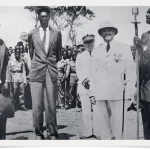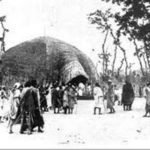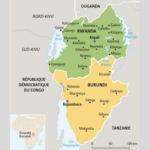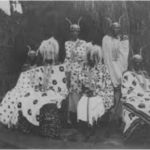The Social System Of The Banyarwanda
On the 1stJuly, 1962, the twenty fourth new African nation came into being.. This was the Republic of Rwanda, which had hitherto formed a part of the Belgian Trust Territory of Ruanda-Urundi. This highland country, right in the centre of Africa, covers an area of. 10,165 square miles and is, with its two and a half million inhabitants, one of the most densely populated areas south of the Sahara
Up till January 1961, when the republic,was first proclaimed, Rwanda had been one of the interlacustrine Kingdoms, and had been studied by scholars of many different disciplines. The firm impression conveyed by the various studies was of a homogeneous unit,.based firstly on the traditional monarchy which was subsequently continued as a separate territory of colonial administration. Homogeneity was further emphasized by the fact that, as scholars and administrators observed, the inhabitants thought of themselves as one people who spoke one common language, Kinyarwanda.
However closer observation and analysis demonstrates the variety within and the complexity of Rwanda society. But this variety and the complexity of underlying principles of the social structure did not destroy the image of homogeneity. On the contrary, it was its uniquely complex structure which distinguished it from other neighbouring Kingdoms and was one of the means through which it established its own identity, both to outsiders and to the people themselves
The heterogeneous character of Rwanda society manifested itself to observers in the presence of three ethnic groups, which exhibit different physical characteristics, the Tutsi, Hutu and Twa. These formed sixteen, eighty three and one per cent of the population respectively.
Apparently these ethnic groupe coincided to a large extent with social cleavage based on political hierarchy. On the one hand, rulers, with the King as their apex were identified with Tutsi. In this context the Tutsi stood out as the aristocrats providing the personnel for the machinery of government. On the other hand the ruled were identified with Hutu.
However, as will be shown, both these assomptions need to be qualified. It was also held that ethnic differences coincided with social cleavage based on occupation in that Tutsi were cattle people while Hutu were agriculturalists.
The Twa on the other hand were hunters, gatherers and potters, living partly in small groups scattered all over the country and partly as mobile groups of hunters or singers and story tellers. In this study, when speaking of duality in Rwanda society, I will be referring to Tutsi-Hutu relationships. Twa were dispersed and numerically unimportant. They had very little if any impact on the overall cultural pattern either of traditional or modern Rwanda society.
Because of this and their lack of influence on the conflict situation which arase, they will be left out of this study unless they need to be drawn in when de facto they did play a role of sufficient importance in relation to the subject matter of this study.
The ethnic groupe making up Rwanda society perpetuated themselves through endogamy. Miscegenation by legal mariages rarely occurred. However sufficient people show in their physical features proof of a certain amount of mixing of the ethnic groups such as to justify the assumption that it happened not infrequently. It is not surprising that this heterogeneous composition of Rwanda society and its social differentiation has led to its being identified as a caste structure.
However caste as an analytical model remains primarily a concept expressing an Indian phenomenon, not only including endogamy, hierarchy and occupational specialisation, but also repulsion. If we accept these differentia which are given a positive value based on religious metaphysic, then we should be extremely careful in applying the concept of caste to the different ethnic groups in Rwanda. While I shall notbe concerned in this thesis to argue the case in detail for and against the classification of Rwanda society as a caste system, I prefer not to refer te the groups concerned in this study as castes.
There is considerable intracultural and regional variation in Rwanda which, as I will develop, are of greater importance than hitherto may have been recognised. These variations are also reflected in the different social institutionscontained within Rwanda society.
The successful movement for independence by the people of Rwanda however was accompanied by violent conflict between the two groups. Because this happened at a time and in a continent where conflicts of this nature were not untypical, the danger exists of dismissing it as a typical pattern of African tribal society. The danger is all the greater ifthe conflict results in overthrowing the “monarchy” and doing away with “feudalism” as elements which have no part in “modern”society. I believe however that this is an all too easy statement and does not answer fundamental questions about the nature of the particular form which conflict took in Rwanda.
The problem with which I shall be principally concerned in this thesis is the explanation of the conflict situation which arose in 1959.
An analysis is needed not only of the reasons why conflict erupted into open violence at this particular moment, but also of the reasons leading to the alignment of the two groups of people involved.
My method of approach will be first to make a functional analysis of the traditional Rwanda social system and to examine how far there were elements of conflict inherent in the principles of social organisation or between the various groups.
Secondly I shall examine the impact of new pressures and opportunities external to traditional society, during the period of EUropean control dating from the beginning of this century.
Finally I shall analyse the situation at the moment of open conflict correlating the form it took with the effect of these new pressures and opportunities on the traditional system.
This problem evidently poses specific difficulties of functional analysis of a highly complex society which has to be considered as a unit containing considerable cultural and regional variations.
Moreoyer we have the problem of a functionel approach in the examination of a society undergoing radical change over a period of time.
One problem in the analysis of traditional society is that we are dependent on historical sources. No study has been published on traditional Rwanda society as a whole. Maquet’s study deals with the central part of Rwanda and he obtained his information, as he confesses in his introduction to “The Premise of Inequalityll”, (1961) exclusively from Tutsi informants.
In 1960 Gravel did fieldwork in Gisaka in Eastern Rwanda and was thus able to draw attention to regional cultural variation, and the working of a community at the time of “the play for power” at the moment the country reached independence. The anthropologist d’Hertefelt published a number of studies as did Kagame. The former gave more attention to the Hutu, the latter to the Tutsi.
However a vast amount of material ofadescriptive and historical nature is available. My attempt to reconstruct the working of traditional society has been helped by my access to the sources contained in the Rapports Annuels of the white Fathers especially those from 1900 te 1918.
These it would seem to me are of great importance, not onlv because the Fathers had been established in severalparts throughout the country for seven years before any form of civil administration was set up by the German authorities, but also because of the quality of the reporting by such persons as Fr. Schumacher, known for his publications in Anthropos as far back as 1910. They alone were able to observe at firstshand the traditional structure and the first impact of new values exterior to that structure.
In the analysis of the traditional system we have not only to examine the existence of tensionswithin the society but also the principles of social organisation which were able to contain these latent conflict situations.
Previous analyses of the Rwanda social structure have been set in terms of the earlyfunctionel approach, stressing the integration of the social system. Maquet’s study in particular puts across an image of a highly stratifiedbut also highly centralised society with a remarkabledegree of social integration and cohesion, and in doing so stressed the functionalist’s impression of durable equilibrium, expressed in his premise of inequality. Althaugh perfectly permissible as an analytical tool, this study has the disadvantage of presenting a static society.
However Simmel has stressed the point that “no group can be entirely harmoniaus for it would then be devoid of process and structure” Closer, 1956 p.31).
More recent studies e.g. Fallers (1957), Kuper (1963) and Beattie (1965) have further stressed the dynamics of and conflict in social systems and demonstrated that the social institutions not only do not always complement one another harmoniously but are conflicting in one degree or another.
Initial reading, especially of the Rapports Annuels, made it evident that Rwanda was no exception. Althaugh a general overall description of Rwanda society and culture is possible, there existed within it not only cultural variations but also various avenues for competition and potential conflict in the political and economic field. Hence even in traditional Rwanda society there were signs of opposition and tensions which threatened the internal cohesion of the principles of social organisation and thus affected the relationships between the groups of people within the boundaries of the Rwandan kingdom. Leach in his Political Systems of Highland Burma writes:
“Wemust recognise that few if any of the societies which a modern field worker can study show any marked tendency towards stability. On the other hand Ihold that it should be possible for anthropologists to develop methods for analysis of changing social systems.” (1957 p.285)
The Rwanda material shows how a diachronic analysis of social change is necessary for the explanation not only of the ultimate conflict situation that arose but also of the principles of social organisation which were able to contain latent conflict within the traditianal system.
In tracing the effects of new pressures and opportunities in traditional Rwanda society which resulted in a situation of incompatible opposition between two groups of people, the arrows of factual correlation will point away from the past but at the level of intellectual correlation the arrows will point both ways. In analysing the conflict situation which arose in Rwanda at the moment of independence, it is important to distinguish those elements of conflictwhich were latent in the traditional system from new factors of conflict introduced through external influence. The system provided sufficient alternative avenues for competition and redress of grievances to prevent conflicting persons and groups from reaching a position of incompatible opposition. Through changes introduced in the system, new wants were created, at the same time as some important avenues for competition were closed. In this way the system lost its flexibility when competitionbetween persons and groups had increased.
Although the idea of conflict may convey the notion of destruction, social conflict is closely related to the constructive process of social cohesion. Conflict at one level may engender cohesion at another. I shall demonstrate in my analysis of the development of the conflict situation how this resulted at one level in incompatible opposition between groups and at another level in creating group identity and strengthening group cohesion. Moreover I will demonstrate that there had been no development of alternative avenues of legitimate competition.
This was the situation at the moment when the seat of government was to be vacated and the system found two incompatible contenders between whom the only form of communication had become the “minimum farm of socialisation” which is open hostility. Functional flexibility and dynamism had gone out of the system where it had for so long played a functional role in upholding a complex heterogeneous structure within the boundaries of its homogeneous identity.
https://uk.amateka.net/the-social-system-of-the-banyarwanda/History of kingsOn the 1stJuly, 1962, the twenty fourth new African nation came into being.. This was the Republic of Rwanda, which had hitherto formed a part of the Belgian Trust Territory of Ruanda-Urundi. This highland country, right in the centre of Africa, covers an area of. 10,165 square miles and...BarataBarata rpierre@ikaze.netAdministratorAMATEKA | HISTORY OF RWANDA




